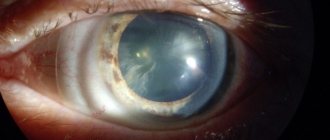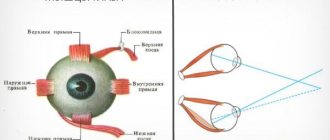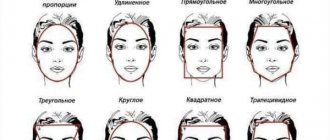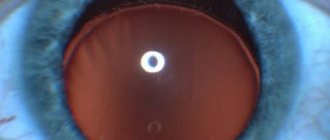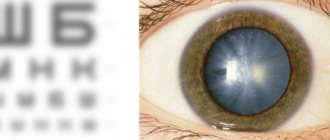Cataract (literal translation from Greek - “spray of a waterfall”, “lattice”) is a loss of transparency of the eye lens, caused by a change in the structure of the protein in its composition, and leading to various vision pathologies. Pathological processes sometimes develop rapidly, but can proceed sluggishly over a long period of time. In any case, cataracts are classified as serious diseases, and without proper attention to them, they will lead to complete or partial loss of vision. The most effective way to combat cataracts is to replace the natural lens with an artificial analogue.
Introduction
For the first time such an operation was carried out by Herold Ridley. It did not bring the desired result, just like subsequent operations. There was no suitable technique, necessary equipment, or decent lenses for transplantation. However, the idea received a powerful impetus and began to develop rapidly.
In case of cataracts, the patient and his attending physician are faced with the question: which lens is better to install: domestic or imported?
In order to correctly navigate when choosing this high-tech product, you need to have basic knowledge about it, and maximum information about manufacturers and sellers of quality lenses. The patient’s future quality of life depends on the right choice. After all, the lens should take root painlessly, last as long as possible, improve vision and not cause discomfort.
The main valuable advantages of an artificial lens are its transparency (degree of transparency) and flexibility. And:
- highest degree of compatibility with body tissues
- excellent transmission of light and color
- glare protection (anti-glare effect)
- UV protective functions
- ensuring high-quality and stable improvement of the patient’s vision
While transparency was easy for developers and manufacturers to handle right from the start, flexibility was a problem. Due to the lack of flexibility of the product, rejection, numerous inflammatory processes, and much more occurred. It was often necessary to replace the implanted lens with a new one, and the surgeon was forced to make a long incision in order to correctly place the inflexible (or poorly bendable, non-elastic) lens. It was necessary to put stitches after the operation.
Modern artificial lenses are an intraocular lens (IOL), which has the property of refracting light, creating a correct and clear image on the retina. The elasticity index is so high that the lens can be rolled into a tube. This allows the surgeon to achieve the most accurate placement of it through a microscopic incision - it straightens on its own, taking on the spherical shape of the eye. And there is no need for stitches, which significantly shortens the rehabilitation (postoperative) period. Almost immediately after the operation, the patient is able to leave the clinic independently, and the operation itself lasts about 15 minutes.
Restrictions after cataract removal
Life after surgery undergoes changes until the final healing and stabilization of the condition.
Prohibited:
- after cataract surgery, you should not watch TV for a long time; it is better to exclude it from possible pastime;
- sleep on the side of the operated eye;
- apply decorative cosmetics to the eyelids and eyelashes;
- drink alcohol, strong coffee and tea;
- drink plenty of fluids; if this restriction is not observed, there is a risk of edema and increased IOP;
- dye your hair and perm your hair;
- drive a car and engage in potentially hazardous activities;
- be in dusty, smoky rooms, spaces where the air is dry due to the operation of radiators and air conditioners;
- rub the operated eye;
- lift weights more than 5 kg;
- engage in sports, especially those associated with lifting weights and shaking the body;
- hot shower, exposure to the sun, visiting the bathhouse and sauna.
If restrictions and prohibitions are not observed, there is a risk of increased intraocular pressure, corneal edema, retinal detachment and displacement of the new, artificial lens.
How to choose a lens?
You need to understand that the implanted lens serves the person for the rest of his life. These are not contact lenses that can be changed depending on personal preference. You can’t go to a pharmacy and choose one model or another just because you like it.
The selection is carried out by a specialist, based on a comprehensive study of the condition of your visual system. The retina, optic nerves, vitreous body, blood vessels of the brain and eyes, and much more are tested. Complete restoration of vision after lens replacement surgery is only possible if all these components work normally. A good ophthalmologist will not guarantee a 100% restoration of visual acuity, since if there is pathology in the above organs, the improvement in vision will be partial. For example, if a patient has difficulty seeing close up, then after the operation he will still have to select appropriate glasses. But his ability to clearly see objects in the distance will be restored.
The first conclusion is that the choice of lens is influenced by the presence of pathologies in the patient before surgery.
The properties of an artificial lens are completely identical to its natural counterpart. The design has the shape of a spherical lens with a support zone (ears that fix the lens strictly in its designated place).
In the vast majority of cases, preference is given to flexible lenses made of hydrogel, silicone and acrylic. However, there are exceptional cases when the doctor is forced to implant hard lenses. These materials are of hydrocarbon origin, which means they have increased elasticity - they change shape without deforming. In addition, many flexible lenses (for example, yellow ones) protect the eyes from harmful radiation from electrical devices (computer monitors, televisions, bright sunlight). Anti-reflective properties and the ability to change curvature, adjusting to different distances, are also important.
The second conclusion is that the choice of lens is influenced by the material from which it is made.
When selecting a lens, the doctor must take into account all the anatomical features of the patient, changes and pathologies of all parts of the eye. The size of the eyeball, the degree of myopia (or farsightedness), the length of the eye muscles, etc. are taken into account. The shape, size, thickness of the selected lens, length of the supporting part, etc. depend on this.
Conclusion three – the choice of lens is influenced by the individual characteristics of the patient
Today, the market offers a huge variety of types of artificial lenses from numerous manufacturers, both domestic and foreign. And this cannot but influence our choice, greatly complicating it. Most doctors prefer American or German implants. The lens made in India is considered to be the worst. Their quality leaves much to be desired. This will be discussed in detail below.
Conclusion four: the choice of lens is influenced by the reputation of the company and the country of manufacture
Diagnosis of cataracts
The developing disease can be noticed immediately. The lens takes on a light cloudy tint. At the beginning of the development of the disease, the disease can be diagnosed using ophthalmological instruments.
If the development of cataracts is not too advanced, a specialist can conduct an examination using a slit lamp , which is used to examine the eye. To dilate the pupil, they resort to medication in the form of drops. The direction of the lamp rays makes it possible to make an optical incision through the eyeball.
The disease can be diagnosed using a slit lamp
This method allows you to accurately assess the location and severity of changes in the ocular structure. Patients who received drops upon completion of the examination are prohibited from driving a car for several hours.
Also, specialists are required to conduct endothelial microscopy of the corneas , which is necessary in order to determine by what method the lens will be removed.
Corneal endothelial microscopy
What types of eye lenses are there and their cost?
Before you get acquainted with the advantages and disadvantages of products from global companies that produce artificial lenses, you need to form a simple idea of their types and purposes.
So, the lenses differ:
1) According to the material of manufacture:
- hard. They are used in extreme cases when there are contraindications to the use of other types. During the operation, an incision of up to 12 mm is required, followed by sutures. They were removed only after 6 months. Often the lens did not take root and caused a lot of trouble for the patient.
- soft . Thanks to their elasticity and resilience, the use of the latest technologies, it has become possible to perform seamless operations (phacoemulsification). Cases of rejection and various complications are minimized and practically absent. Both surgery and rehabilitation take significantly less time.
2) According to the shape of the lens:
- spherical. This form of IOL is characterized by uneven refraction of the light beam in its various parts. And the scattering of the light beam leads to glare and the effect of overexposure, and also deteriorates the quality of vision.
- aspherical. This shape promotes uniform refraction of light across the entire surface of the lens. This eliminates glare and glare from bright light stimuli (for example, from car headlights or street lights), especially in the dark, with maximum pupil dilation. Aspheric IOLs have better color rendering and increased contrast.
3) According to correctional possibilities:
- monofocal. Made from synthetic materials, such lenses do not have the ability to change curvature, adjusting to changing distances, as natural lenses do. Therefore, distance vision is corrected, and for working at close distances it is necessary to select appropriate glasses.
- Multifocal. The design of this type of lens uses special optics, where, depending on the distance to the object in question, different zones of the lens surface are involved. The properties of such a lens are as close as possible to the properties of a natural lens. However, the complexity of calculating these zones and the high cost of manufacturing significantly increase the cost, and, consequently, the final price of the product.
- toric. They are selected individually, based on the indications of the amount of astigmatism present. These lenses have a built-in cylinder that corrects astigmatism. After implantation of a toric lens, the patient can completely abandon glasses with cylinders. However, vision improvement occurs only in one direction - either clearly visible in the distance or close.
- multifocal toric. In addition to correcting astigmatism, such lenses improve vision at different distances - far and near. For the complexity of calculations during selection, comfort and excellent vision, the patient will have to fork out money - these models are the most expensive.
- with filters that protect the eyes from radiation. These models belong to the premium class. They contain yellow pigments that cut off blue rays from the invisible part of the light spectrum. The natural human lens has the same properties.
- phakic. When contraindications to lens replacement surgery are discovered, special overlays are used on the native lens to improve its properties. These are phakic IOLs.
- accommodating. These are monofocal lenses that can change position in the eye.
American artificial lenses for eyes
Perhaps the most popular and sought-after products are produced by Alcon. It deservedly occupies a leading position in the ranking of manufacturers of intraocular lenses. Over 12 years, more than 25 million lens replacement operations have been performed worldwide using IOLs from this particular company. Doctors around the world prefer Alcon lenses.
- enVista (Bausch&Lomb
- AcrySof ReSTOR Toric (Alcon)
- AcrySof ReSTOR ASFERIC from Alcon
- AcrySof Natural
- AcrySof IQ. Special development is aimed at maximum suppression of aberrations (visual interference). The back is shaped so that light rays are focused into one narrow area of the retina. This prevents the appearance of glare, halos, etc., both in bright light and at dusk.
- AcrySof Toric
- Crystalens AO Lens
- Akreos Adapt AO (Bausch&Lomb)
Each of the models has its own advantages and features, but what is common to the entire Alcon product line are:
| pros | Minuses |
|
|
Useful video
Brief answers from practicing physician I.S. Tkach about the postoperative period after cataract removal: general information, use of eye drops, restrictions, glasses and lenses, return to work and eye recovery.
Rehabilitation after lens replacement for cataracts, if all specialist recommendations are followed, lasts less than 6 months. This will restore visual acuity and prevent the development of complications, including secondary cataracts.
Author's rating
Author of the article
Alexandrova O.M.
Articles written
2031
about the author
Was the article helpful?
Rate the material on a five-point scale!
( 3 ratings, average: 3.00 out of 5)
If you have any questions or want to share your opinion or experience, write a comment below.
German lenses for eyes against cataracts
In Russia, the products of the German company ZEISS are very popular and available. A large assortment, variety of models and affordable pricing, combined with excellent quality, have brought ZEISS to a leading position in the ranking of IOL manufacturers.
The company has been producing optical instruments for more than 100 years. At the next congress of the EOCRH (cataract surgeons), the company presented its new developments - innovative lenses for cataracts - of the highest quality and excellent technical characteristics, which have not yet been seen on the IOL market.
The patented SMP (smooth micro phase) optics technology used by its specialists allows achieving ideal image quality without glare, light loss and refractive errors.
Brief overview of ZEISS IOL models 1. Multifocal lenses:
- Aspira Diffractiva from Human Optics
- AT LISA (AT LISA 809M / Acri.LISA 366D)
Pros:
- Asymmetrical distribution of light fluxes between foci, which improves the quality of vision and reduces glare
- High-tech lens surface coating ensures independence from pupil size
- the absence of sharp corners on the coating leads to negligible loss of light and a perfectly clear image
- aspherical shape, which has a beneficial effect on vision parameters
- AT LISA toric 909M
- AT LISA tri 839MP is the first trifocal lens registered with us.
Pros:
- Transplanted using the MICS method, the lens is in a cartridge, which improves the quality of vision at medium distances
- soft focusing at any distance and in any lighting
2. Monofocal lenses
- CT ASPHINA 404
- CT ASPHINA 409MP
- CT ASPHINA 603P
- CT LUCIA 601P/601PY
- ST ASPHINA 509M
- CT SPHERIS 203P (preloaded)
- AT Torbi 709M
- Oculentis Mplus (lentis ls 313)
- Diffractiva-aAY from Human Optics. Yellow lens made of hydrophilic material (acrylic). Optimal balance between focuses.
A joint product of the German company Oculentis Gmbh and the Dutch company Topcon. The only lens that corrects presbyopia. The unique innovative technology allows manufacturers to achieve maximum smoothness of the transition of optical zones. The design of the lens protects the posterior capsule of the lens from clouding.
Pros:
- complete restoration of vision at any distance
- minimum loss of photosensitivity and contrast
- no image shifts (effective fixation)
- no glare, flare, or split images
- barrier edging protects against secondary cataracts
- presence of a light filter
- the material is not rejected by the body
- The size of the pupil does not affect the properties of the lens. Already in the first hours after the operation, the patient can read, work on the computer and watch TV.
Common to all IOL models from German manufacturers are:
| pros | Minuses |
|
|
Are there complications after laser lens replacement?
Although laser lens removal is the safest method of lens replacement, there may be some complications. They occur very rarely, in approximately 0.1% of cases. There are two types: early and late complications. Among the early ones:
- Inflammation of the iris and choroid. This is a natural reaction of the body, as to any surgical intervention. It goes away on its own within 1-2 days.
- Increased pressure in the eye. It is treated with drops, and in severe cases it is necessary to make punctures.
- Hemorrhages in the anterior chamber of the eye. This occurs if the iris is affected, which is extremely rare;
- Retinal disinsertion. It can occur as a result of injury.
- IOL displacement.
Late complications include:
- Swelling of the macular part of the retina (fluid accumulation in the macula), it is treated using conservative and surgical methods.
- Secondary cataract. When a primary cataract is removed, the posterior lens capsule remains in place. Sometimes its epithelial cells begin to grow, which reduces the transparency of the intraocular lens and leads to deterioration of vision. Secondary cataracts are treated using laser dissection. The doctor removes overgrown epithelial tissue from the capsule and returns transparency to the capsule.
If you follow all the doctor’s recommendations, there should be no complications. The type of surgery and type of IOL are chosen by the doctor. The cost of the procedure depends on the type of lens. Today it is considered the safest and most effective and helps restore vision to patients with very severe eye pathologies.
Which lens is better, American or German, for cataracts?
Some people do not quite understand the differences between American lenses and German ones:
The user received the following response from an ophthalmologist.
Although the reviews presented are not new, they are still relevant today.
So, judging by the reviews, the rating of the best lenses looks like this:
- Acrysof IQ. The average cost is 22,000 rubles.
- Human Optics PC Iol Model Aspira- aAY. The average price will be 20,000 rubles.
The list is not large, but it is represented by the highest quality and most popular lenses that are used after cataract surgery.
Eye care after rehabilitation
You should wash your face carefully, avoiding getting water and soap into the operated eye. To do this, it is better to replace the washing procedure with regular wiping with a damp cotton swab.
When washing your hair, you should tilt your head back to avoid water getting into your eyes.
In case of accidental contact with water, the eyes should be rinsed with an aqueous solution of furatsilin.
To care for the operated eye and remove secretions, it is recommended to wipe the eyelids with a swab soaked in boiled water in the direction from the outer to the inner corner of the eye. Movements should be soft, careful, and not affect the eyeball.
When going outside for 10 days after surgery, you should wear a special bandage.
Manufacturers from other countries
- Hoya ISert® 251 from Hoya Surgical Optics, Japan. Pre-installed posterior chamber, unique two-piece block design provides maximum visual acuity and clarity.
| pros | Minuses |
|
|
- FineVision (PhysIOL, Belgium). Super elastic, aspherical lens, with yellow spray pigment.
| pros | Minuses |
|
|
Selection of glasses after cataracts
In the first time after surgery, there is no clear, good vision of objects, with the exception of implantation of a multifocal lens. Therefore, during the rehabilitation period, a specialist selects corrective glasses or lenses, often with different diopters. They are made to order.
When going outside, you should avoid exposing the operated eye to sunlight and ultraviolet rays. Therefore, it is recommended to wear special sunglasses with green or yellow lenses. They are sold in pharmacies and salons or optical stores.
Indian intraocular lenses
One of the largest manufacturers of medical products in India is Appasamy Ocular Devices Pvt. Ltd. _ Considering the large population of the country and the presence of government programs for medical support of the population, companies engaged in this area receive good profits within the country and develop successfully. More than 80% of IOLs used by ophthalmologists in the country are manufactured by specialists from this company. The process of conquering sales markets abroad is also progressing successfully. Appasamy has a lens manufacturing plant (Ellis Opthalmics) in New York.
Cataract is the most global problem in India, due to the abundance of sunlight, food culture, lifestyle, and so on.
The company's products are quite competitive, as they are a cheap alternative to expensive global brands. Regularly exhibits its products at European and American exhibitions, receiving in return tax reductions, which also has a positive effect on the price of the product.
- OcuFlex . There are two varieties in production F6125SQY and YPH55
- Acryfold 502 . It is registered in Russia and recommended for use. After implementation, it shows good visual results. Complications in the postoperative period and during the procedure itself are minor. Supplied in a preservative liquid in a glass bottle. The kit includes a cartridge and an injector.
It is difficult to give an unambiguous assessment of eye lenses from Indian manufacturers:
| pros | Minuses |
|
|
Reviews of Indian eye lenses:
Prevention
To prevent the development of cataracts or complications after surgery, the following recommendations should be followed:
- limiting visual load, reducing TV watching, computer work;
- ensuring good lighting when reading, working at the monitor;
- balanced diet rich in healthy ingredients, vitamins and minerals;
- daily exposure to fresh air;
- doing exercises or gymnastics for the eyes;
- taking multivitamin complexes;
- preventive examinations at least 2 times a year by an ophthalmologist;
- timely treatment of infectious and inflammatory processes occurring in the organ of vision;
- contacting a specialist at the slightest deterioration in visibility or loss of visual acuity.
Russian lenses for eyes
How to choose a lens for the eye, whose brand and price is better? What types of Russian-made lenses are there? When replacing the lens of the eye, which is better, ours or an imported one? This question cannot but arise in the mind of a reasonable person. However, the answer to this is not as obvious as it might seem at first glance. Well-rooted stereotypes hinder the promotion and popularization of products of Russian manufacturers. This fully applies to the production of eye lenses.
Here is a clear example of how the lack of a legislative framework, the ability to organize and develop production in our conditions, and the lack of support from domestic consumers prevented a Russian manufacturer from launching the production of MIOL Record-3 trifocal lenses, which at that time had no analogues in the world. In 2000, she registered this new product for launch into production. It allowed the patient, after implantation, to see equally well at any distance, without additional devices. However, the only mold supplier went bankrupt and a replacement could not be found. Having not received government support for purchasing molds abroad, the company curtailed production, and the innovative idea was immediately picked up by Western competitors. They successfully established the production and sale of this unique product. And now the Russian consumer is forced to purchase these lenses from foreign manufacturers, at a very high price.
Domestic eye lenses reviews:
So, there are three Russian manufacturers of intraocular optics:
- NPP Reper-NN
- LLC "Latan" 40 IOL models.
- CJSC NPO ICE
| pros | Minuses |
|
|
Prices for popular IOL models
By country:
| A country | Lower price limit | Upper price limit |
| USA | RUR 9,900 | RUB 94,000 |
| Great Britain | RUB 18,000 | RUB 85,000 |
| Germany | RUB 9,000 | RUB 95,000 |
| Russia | RUB 7,000 | |
| India | RUB 14,000 |
By manufacturer:
| "Acrysof" Alcon (USA) | RUR 9,900 |
| "Acrysof" Natural Alcon (USA) | RUB 14,000 |
| "Acrysof" IQ Alcon (USA) monoblock. | RUB 18,000 |
| "Acrysof" IQ Toric Alcon (USA | RUR 38,000 |
| Acrysof IQ PanOptix | RUB 89,900 |
| "Acrysof" ReSTOR Alcon (USA) | RUB 59,000 |
| "Acrysof" ReSTOR Toric Alcon | RUB 94,000 |
| Tecnis monofocal, Abbott Medical Optics (USA) | RUB 18,000 |
| Tecnis toric, f. Abbott Medical Optics (USA) | RUB 53,000 |
| Tecnis Multifocal, f. Abbott Medical Optics (USA) | RUB 69,000 |
| Aspira®-aAY HumanOptics (Germany) | RUB 9,000 |
| TORICA®-aAY HumanOptics (Germany) | RUR 21,000 |
| DIFFRACTIVA®-aAY HumanOptics (Germany) | RUR 36,000 |
| Carl Zeiss Asphina 404 | RUR 34,900 |
| CT Asphina 409M Carl Zeiss (Germany) | RUB 18,000 |
| CT Asphina 509M Carl Zeiss (Germany) | RUB 19,900 |
| AT LISA 809M Carl Zeiss (Germany) | RUB 55,000 |
| AT LISA tri 839MP Carl Zeiss (Germany) | RUB 95,000 |
| Rayner SuperFlex Aspheric (UK) | RUB 19,900 |
| Rayner C-Flex (UK) | RUB 18,000 |
| Rayner Toric (UK) | RUR 23,000 |
| Rayner multifocal (UK) | RUR 39,000 |
| Rayner M-Flex Toric (UK) | RUB 85,000 |
| SPK (PSP-3) (Russia) | RUB 7,000 |
| Acryfold 601 India | RUB 14,000 |

